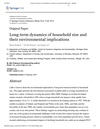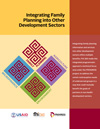 What are the environmental implications of changing household sizes? A recent article by Mason Bradbury, M. Nils Peterson, and Jianguo Liu, published in Population and Environment, analyzes data from 213 countries over 400 years and finds the average number of occupants per home tends to decline as population grows. This dynamic, they write, indicates that accommodating housing could prove to be one of “the greatest environmental challenges of the twenty-first century.” As countries develop and urbanize, “according to convergence theory, household size decreases (often from greater than five to less than three).” Other cultural shifts, like increasing divorce rates, urban sprawl driven by rising affluence, decreasing numbers of multigenerational households, and larger houses (in the United States, homes more than doubled in size between 1950 and 2002, according to the article) compound the issue. As population growth continues in parts of the world, these trends pose critical questions for conservation and environmental sustainability, since “households are the end consumers of most natural resources and ecosystem services.”
What are the environmental implications of changing household sizes? A recent article by Mason Bradbury, M. Nils Peterson, and Jianguo Liu, published in Population and Environment, analyzes data from 213 countries over 400 years and finds the average number of occupants per home tends to decline as population grows. This dynamic, they write, indicates that accommodating housing could prove to be one of “the greatest environmental challenges of the twenty-first century.” As countries develop and urbanize, “according to convergence theory, household size decreases (often from greater than five to less than three).” Other cultural shifts, like increasing divorce rates, urban sprawl driven by rising affluence, decreasing numbers of multigenerational households, and larger houses (in the United States, homes more than doubled in size between 1950 and 2002, according to the article) compound the issue. As population growth continues in parts of the world, these trends pose critical questions for conservation and environmental sustainability, since “households are the end consumers of most natural resources and ecosystem services.”
 Development initiatives aimed at improving access to contraceptives are largely limited to health sectors, but FHI 360’s Integrating Family Planning into Other Development Sectors suggests ways to integrate these efforts into environmental, agricultural, and financial interventions too. The report outlines lessons learned during FHI 360’s five-year PROGRESS project, an interdisciplinary attempt to improve the knowledge of, and access to, family planning information and services by partnering with other development sectors. In Kenya, FHI 360 teamed with the Green Belt Movement to train “green volunteers” in family planning and “environment, health, and population” education. After eight months, 81 percent of the 42 trained volunteers correctly answered at least 7 out of 10 questions reflecting essential family planning knowledge. Another project in Kenya integrated family planning and health services during recurring, one-day “farmer field days,” giving health consultations (including physical examinations, family planning services, and HIV counseling and testing) to 80 percent of 2,344 attendees. Although dairy cooperatives were concerned at first that the health services would distract farmers from educational workshops, attendance actually increased and other cooperatives began asking for a similar program at their events.
Development initiatives aimed at improving access to contraceptives are largely limited to health sectors, but FHI 360’s Integrating Family Planning into Other Development Sectors suggests ways to integrate these efforts into environmental, agricultural, and financial interventions too. The report outlines lessons learned during FHI 360’s five-year PROGRESS project, an interdisciplinary attempt to improve the knowledge of, and access to, family planning information and services by partnering with other development sectors. In Kenya, FHI 360 teamed with the Green Belt Movement to train “green volunteers” in family planning and “environment, health, and population” education. After eight months, 81 percent of the 42 trained volunteers correctly answered at least 7 out of 10 questions reflecting essential family planning knowledge. Another project in Kenya integrated family planning and health services during recurring, one-day “farmer field days,” giving health consultations (including physical examinations, family planning services, and HIV counseling and testing) to 80 percent of 2,344 attendees. Although dairy cooperatives were concerned at first that the health services would distract farmers from educational workshops, attendance actually increased and other cooperatives began asking for a similar program at their events.
 What are the environmental implications of changing household sizes? A recent article by Mason Bradbury, M. Nils Peterson, and Jianguo Liu, published in Population and Environment, analyzes data from 213 countries over 400 years and finds the average number of occupants per home tends to decline as population grows. This dynamic, they write, indicates that accommodating housing could prove to be one of “the greatest environmental challenges of the twenty-first century.” As countries develop and urbanize, “according to convergence theory, household size decreases (often from greater than five to less than three).” Other cultural shifts, like increasing divorce rates, urban sprawl driven by rising affluence, decreasing numbers of multigenerational households, and larger houses (in the United States, homes more than doubled in size between 1950 and 2002, according to the article) compound the issue. As population growth continues in parts of the world, these trends pose critical questions for conservation and environmental sustainability, since “households are the end consumers of most natural resources and ecosystem services.”
What are the environmental implications of changing household sizes? A recent article by Mason Bradbury, M. Nils Peterson, and Jianguo Liu, published in Population and Environment, analyzes data from 213 countries over 400 years and finds the average number of occupants per home tends to decline as population grows. This dynamic, they write, indicates that accommodating housing could prove to be one of “the greatest environmental challenges of the twenty-first century.” As countries develop and urbanize, “according to convergence theory, household size decreases (often from greater than five to less than three).” Other cultural shifts, like increasing divorce rates, urban sprawl driven by rising affluence, decreasing numbers of multigenerational households, and larger houses (in the United States, homes more than doubled in size between 1950 and 2002, according to the article) compound the issue. As population growth continues in parts of the world, these trends pose critical questions for conservation and environmental sustainability, since “households are the end consumers of most natural resources and ecosystem services.” Development initiatives aimed at improving access to contraceptives are largely limited to health sectors, but FHI 360’s Integrating Family Planning into Other Development Sectors suggests ways to integrate these efforts into environmental, agricultural, and financial interventions too. The report outlines lessons learned during FHI 360’s five-year PROGRESS project, an interdisciplinary attempt to improve the knowledge of, and access to, family planning information and services by partnering with other development sectors. In Kenya, FHI 360 teamed with the Green Belt Movement to train “green volunteers” in family planning and “environment, health, and population” education. After eight months, 81 percent of the 42 trained volunteers correctly answered at least 7 out of 10 questions reflecting essential family planning knowledge. Another project in Kenya integrated family planning and health services during recurring, one-day “farmer field days,” giving health consultations (including physical examinations, family planning services, and HIV counseling and testing) to 80 percent of 2,344 attendees. Although dairy cooperatives were concerned at first that the health services would distract farmers from educational workshops, attendance actually increased and other cooperatives began asking for a similar program at their events.Topics: Africa, aging, agriculture, demography, development, economics, energy, environment, family planning, funding, global health, Kenya, maternal health, PHE, population, Reading Radar, security, U.S., urbanization
Development initiatives aimed at improving access to contraceptives are largely limited to health sectors, but FHI 360’s Integrating Family Planning into Other Development Sectors suggests ways to integrate these efforts into environmental, agricultural, and financial interventions too. The report outlines lessons learned during FHI 360’s five-year PROGRESS project, an interdisciplinary attempt to improve the knowledge of, and access to, family planning information and services by partnering with other development sectors. In Kenya, FHI 360 teamed with the Green Belt Movement to train “green volunteers” in family planning and “environment, health, and population” education. After eight months, 81 percent of the 42 trained volunteers correctly answered at least 7 out of 10 questions reflecting essential family planning knowledge. Another project in Kenya integrated family planning and health services during recurring, one-day “farmer field days,” giving health consultations (including physical examinations, family planning services, and HIV counseling and testing) to 80 percent of 2,344 attendees. Although dairy cooperatives were concerned at first that the health services would distract farmers from educational workshops, attendance actually increased and other cooperatives began asking for a similar program at their events.Topics: Africa, aging, agriculture, demography, development, economics, energy, environment, family planning, funding, global health, Kenya, maternal health, PHE, population, Reading Radar, security, U.S., urbanization A Publication of the Stimson Center.
A Publication of the Stimson Center.





